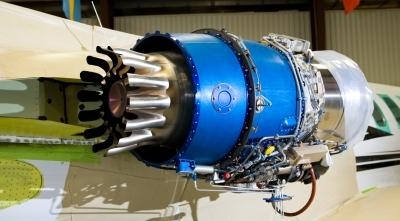Thu, Nov 10, 2011
Legacy Jets Finding New Life In A Difficult Market
Sierra Industries’ Williams FJ44 re-engining programs are
rapidly approaching a total of 60 aircraft, with the input of two
more legacy Citation aircraft for modification. Number 58 in the
series is a Citation S550, slated to become the 12th aircraft
fitted with 2820 lb. thrust FJ44-3A engines. No. 59 is a Citation I
and boasts the Sierra Stallion FJ44-2A upgrade. Both aircraft are
expected to be completed before the end of 2011, making them
potential candidates for the U.S. Government’s 100% Bonus
Depreciation tax allowance.
FJ44 Engine

“We’re gratified by the support for our Williams
FJ44 re-engining programs in today’s challenging aviation
market. This reinforces our belief that well-designed and carefully
updated legacy aircraft continue to be a competitive and
cost-effective alternative to new aircraft models. Sierra’s
hard-won expertise in legacy aircraft modification is recognized by
OEM firms like Hawker Beechcraft, resulting in contracted
technology development for the newly approved 800XPR and upcoming
400XPR retrofit programs,” remarks SkyWay Group and Sierra
CEO Mark Huffstutler.
Building on over 28 years of Citation modification history and
18 years of experience in Citation re-engining, Sierra’s
re-engining lineup includes the highly successful FJ44-2A powered
Eagle II, Stallion and the FJ44-3A powered Super II and Super S-II
modifications. Supporting these modifications with their extensive
in-house manufacturing capabilities, Sierra is among the largest
holders of FAA Parts Manufacturing Approvals (PMA) in the
southwestern US.

Many re-engined aircraft benefit from Williams’ renowned
Total Assurance Program (TAP), the industry’s leading engine
maintenance program for more than 13 years. Compared to the
original JT15-D engines, the TAP program typically saves operators
more than a quarter-million dollars in engine maintenance costs by
the time TBO is reached.
The Williams powerplants also increase efficiency, reducing fuel
consumption, cost and carbon emissions. Operators enjoy substantial
performance improvements, from 35 to 50 knot cruise speed increases
and 300 to 400 NM greater range to dramatically improved climb. All
4 models can achieve FL430 at gross weight in under 25 minutes from
any airport in North America.
More News
Witness Reported The Airplane Was Flying Low And Was In A Left Bank When It Struck The Power Line Analysis: The pilot was on final approach to land when the airplane collided with >[...]
How To Get A Story On Aero-TV News/Feature Programming How do I submit a story idea or lead to Aero-TV? If you would like to submit a story idea or lead, please contact Jim Campbel>[...]
From 2012 (YouTube Edition): A Segment Of The Sport Aviation World That Truly Lives "Low And Slow" Pity the life of ANN's Chief videographer, Nathan Cremisino... shoot the most exc>[...]
Aero Linx: International Business Aviation Council (IBAC) IBAC promotes the growth of business aviation, benefiting all sectors of its industry and in all regions of the world. As >[...]
Execute Missed Approach Instructions issued to a pilot making an instrument approach which means continue inbound to the missed approach point and execute the missed approach proce>[...]
 NTSB Final Report: Cozy Cub
NTSB Final Report: Cozy Cub ANN FAQ: Contributing To Aero-TV
ANN FAQ: Contributing To Aero-TV Classic Aero-TV: Seated On The Edge Of Forever -- A PPC's Bird's Eye View
Classic Aero-TV: Seated On The Edge Of Forever -- A PPC's Bird's Eye View ANN's Daily Aero-Linx (04.29.25)
ANN's Daily Aero-Linx (04.29.25) ANN's Daily Aero-Term (04.29.25): Execute Missed Approach
ANN's Daily Aero-Term (04.29.25): Execute Missed Approach




